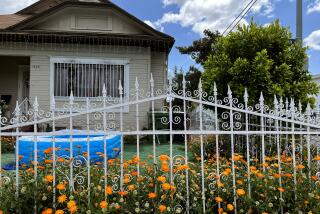Colorful Neighborhood Flaunts Its Independence
NEWBURY PARK â Smack-dab in the middle of muted Newbury Park sits a proud pocket of pigment in the otherwise taupe, tawny, tan and terra-cotta tile-roofed Conejo Valley.
Surrounded by the city of Thousand Oaks--which has the most stringent design and color guidelines for homes in Ventura County--the residents of the Casa Conejo neighborhood defiantly splash their homes in fruit-salad brights: deep lime, juicy melon, tangy grape green and cheery lemon. Not to mention the occasional teal, sky blue and rose.
But a block or two away, neighbors are legally bound to stick within Thousand Oaksâ Precise Plan of Design, which mandates tones âof earthen hue, such as off-white, ochres, siennas, umbers, beiges, tans, browns, natural greens as well as yellows, oranges and reds that are subdued.â
Nowhere does the list mention stormy blue with royal accents--the preferred palette for Noble and Moya Sablickâs low-slung Dorena Drive bungalow.
âIn Thousand Oaks, you just get plain old earth colors,â Moya Sablick said, as she and her grandson filled water balloons on a recent afternoon. âWho wants plain old earth colors?â
âItâs like wearing plain old jockey shorts,â quipped her husband, an airplane mechanic.
The Sablicks, like many of their neighbors in the half-square-mile oasis of Casa Conejo, are suburban rebels who relish the power of the paint brush.
While it may seem like a small thing to haggle over hues, their attitude toward color represents something much larger: freedom from Thousand Oaksâ rules.
Thatâs because Casa Conejo--all 1,050 homes of it--refuses to join Thousand Oaks. The 1960s-era rectangular tract in the Newbury Park area is ringed by the bustling suburb, but its residents have voted down annexation. They fear that joining the cityâs 114,000 residents could mean more taxes, too many picky rules, an end to their rural way of life--and boring paint jobs.
*
âI would call these people rugged individualists that disdain joining the city,â said County Supervisor Frank Schillo, who does not represent Casa Conejo, but gets calls from the residents because of his years as a Thousand Oaks councilman.
âThey want their independence. They donât feel the county interferes in their lives, and the city would.â
Just so, said Betty Hantke, whose cantaloupe cottage on almost an acre of land is one of most colorful homes in the area just south of the Ventura Freeway bounded by Old Conejo Road, Jenny Drive, Borchard Road and Virginia Drive.
âWeâve lived here 26 years, raised our children here and weâre very much individuals,â she said. âWe really love to create and paint and do things our own way. We donât want to be told.â
The daughter of a Finnish carpenter and the co-owner of an auto paint and body shop in Westlake, Hantke and her husband, John, believe itâs their right to be creative with their home.
Thus the lush landscaping--lipstick-red nasturtiums spilling onto the driveway, bobbing hollyhocks and about a hundred trees.
The home also shows their crafty touches--white shutters detailed with hearts painted freehand rather than from a stencil--and gobs of antiques.
âOur house has been cantaloupe for, Iâd say, six years,â Hantke said. âBefore that it was a blue-gray with white trim, and before that a pale yellow with white trim. And before that, it was kind of a Martha Stewart mossy green with white trim. I like to change every so often.â
Were Hantke to live just a block away in the incorporated part of Newbury Park, her creativity would probably be stifled, by the city or, if she bought a newer home, a homeowners association.
Were she to flout the Thousand Oaks law and refuse to paint her home a more subtle shade, she could face misdemeanor charges and a fine.
Aiming to keep aesthetics and property values high in this affluent area, the Thousand Oaks City Council created its design residential standards in the early 1970s.
Surrounded by the craggy Santa Monica Mountains and golden, cactus-specked mesas, the city lets nature be its guide.
Council members picked--and codified--design features, building materials and colors that are âgenerally illustrative and reflective of, and compatible with, the natural setting of the scenic and historic environment of the Conejo Valley in general and the city of Thousand Oaks in particular.â
And more rules have been written since.
Now guidelines govern slope of roof, distance between homes, enclosure of trash cans, the use (or nonuse) of neon and plastics, the size of business signs and more.
The result is a beautifully planned, if sometimes bland, city. It is also a city in which the Suburbans on the road are usually more vivid than the stucco.
That aesthetic purity is exactly what draws many residents to Thousand Oaks. And any proposal to change the design standards draws residents to City Council meetings.
*
In more recently built tracts, homeowners associations are likely to tighten the already strict rules. In some, a request to paint a house must go before a committee first.
âI think the community has come to expect certain standards from the city,â said Geoff Ware, Thousand Oaksâ director of code compliance. âA lot of people move to the city because of the cityâs plan and controlled development and the vision thatâs been created here. Itâs a well-planned city that has nice design and is well maintained.â
And if someone were to paint a ranch-style house fuchsia?
âWhat color is fuchsia? Hot pink?â he asked.
Joking aside, Ware said he and his staff arenât the color police. They act on a complaint-only basis.
To the best of his knowledge, no one who lives in the section of Thousand Oaks that abuts Casa Conejo has complained about flashy paint jobs. But a few, newer Casa Conejo residents do sometimes erroneously call the city for services.
So why did Casa Conejo and a few other pockets of Newbury Park refuse to join Thousand Oaks when the city incorporated in 1964? A lot of it boils down to sewage and a desire to keep things rural.
The majority of the tract, which had its own sewage system, voted no in 1964. Without a sewer system to call their own, the majority of Newbury Park cast a yes vote for annexation.
Bureaucrats generally frown on âislandsâ--unincorporated areas within incorporated cities--such as Casa Conejo, because of the hassle in providing police, code enforcement and other services.
A state law from the mid-1980s that gave the Local Agency Formation Commission power to force islands to annex applies only to areas of 100 acres or more.
For the cityâs part, Thousand Oaks had made a policy of annexing only populated areas if the homeowners petition the city and a majority vote yes.
âWe donât want to force anyone to join the city if they donât want to join the city ,â said Planning Director Phil Gatch. âWe donât strong-arm annexations.â
Thatâs just fine with 35-year Casa Conejo resident Fulton Alexander Archibald, a retired surveyor.
Even though he voted to join Thousand Oaks back in â64, Archibald has only one complaint--the aging streets and storm drains near his Virginia Drive home. âThis is an oasis onto itself,â he said.
Looking at Archibaldâs kelly and lima-bean green house with pink roses, itâs hard to tell whether heâs talking about his home or his neighborhood.
More to Read
Sign up for Essential California
The most important California stories and recommendations in your inbox every morning.
You may occasionally receive promotional content from the Los Angeles Times.






